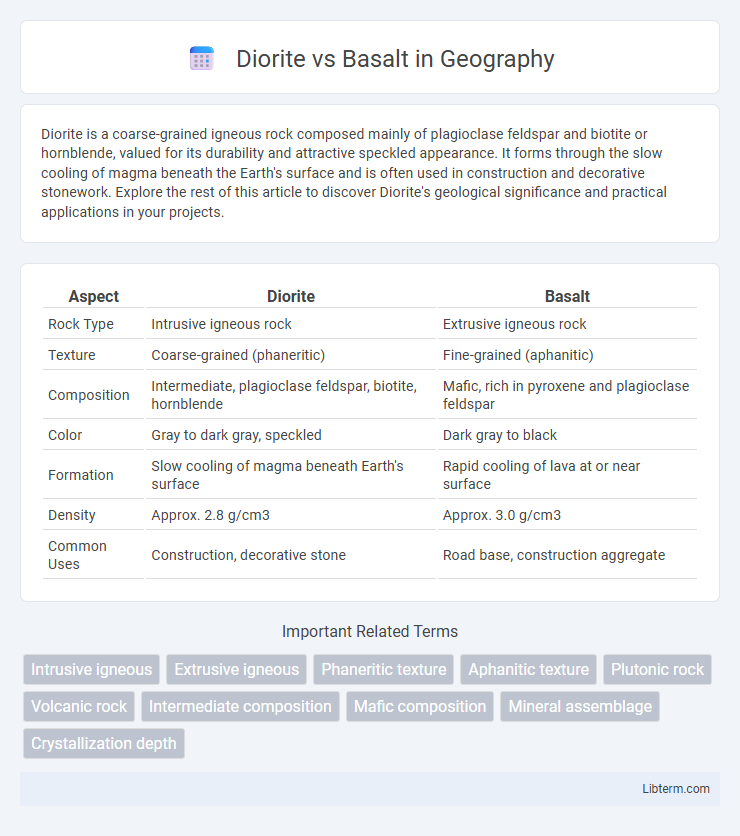Diorite is a coarse-grained igneous rock composed mainly of plagioclase feldspar and biotite or hornblende, valued for its durability and attractive speckled appearance. It forms through the slow cooling of magma beneath the Earth's surface and is often used in construction and decorative stonework. Explore the rest of this article to discover Diorite's geological significance and practical applications in your projects.
Table of Comparison
| Aspect | Diorite | Basalt |
|---|---|---|
| Rock Type | Intrusive igneous rock | Extrusive igneous rock |
| Texture | Coarse-grained (phaneritic) | Fine-grained (aphanitic) |
| Composition | Intermediate, plagioclase feldspar, biotite, hornblende | Mafic, rich in pyroxene and plagioclase feldspar |
| Color | Gray to dark gray, speckled | Dark gray to black |
| Formation | Slow cooling of magma beneath Earth's surface | Rapid cooling of lava at or near surface |
| Density | Approx. 2.8 g/cm3 | Approx. 3.0 g/cm3 |
| Common Uses | Construction, decorative stone | Road base, construction aggregate |
Introduction to Diorite and Basalt
Diorite is an intrusive igneous rock composed mainly of plagioclase feldspar and amphibole, forming coarse-grained textures typically found in continental crust. Basalt is a fine-grained extrusive igneous rock rich in pyroxene and plagioclase, commonly erupting from volcanic activity on oceanic crust and continental regions. Both rocks display distinct mineral compositions and cooling histories that influence their texture and geological occurrence.
Formation and Geological Origins
Diorite forms through the slow cooling of intermediate magma deep within the Earth's crust, resulting in coarse-grained textures rich in plagioclase feldspar and amphibole minerals. Basalt originates from rapid cooling of mafic lava at or near the Earth's surface, typically at divergent plate boundaries or hotspots, creating fine-grained, dense, and dark volcanic rock. Both rocks reflect distinct geological environments, with diorite representing intrusive igneous processes and basalt characterizing extrusive volcanic activity.
Mineral Composition Compared
Diorite primarily consists of plagioclase feldspar, biotite, hornblende, and minor quartz, giving it a coarse-grained texture typical of intrusive igneous rocks. Basalt is predominantly composed of pyroxene and plagioclase feldspar, with smaller amounts of olivine, resulting in a fine-grained texture characteristic of extrusive volcanic rocks. The key mineralogical difference is the higher quartz and hornblende content in diorite versus the mafic minerals like pyroxene and olivine more abundant in basalt.
Texture and Appearance Differences
Diorite exhibits a coarse-grained, phaneritic texture with interlocking feldspar and hornblende crystals, giving it a speckled, salt-and-pepper appearance. Basalt features a fine-grained, aphanitic texture due to rapid cooling, resulting in a dark, uniform surface often rich in tiny vesicles or gas bubbles. The color contrast is notable, with diorite displaying light to medium gray tones and basalt characterized by black or dark gray shades.
Physical Properties: Hardness and Density
Diorite exhibits a hardness of 6 to 7 on the Mohs scale, making it relatively hard and resistant to abrasion, while its density ranges from 2.8 to 3.0 g/cm3, reflecting its coarse-grained texture. Basalt, though slightly less hard with a Mohs hardness around 5 to 6, has a higher density typically between 2.9 and 3.1 g/cm3 due to its fine-grained, mafic composition. The differences in hardness and density between diorite and basalt influence their applications in construction and aggregate materials.
Common Locations and Occurrences
Diorite commonly occurs in intrusive igneous rock formations associated with continental crust, predominantly found in regions such as the Sierra Nevada in California and the Scottish Highlands. Basalt is an extrusive igneous rock primarily formed from rapid cooling of lava at oceanic crusts and volcanic islands, with notable occurrences along mid-ocean ridges and hotspots like Hawaii and Iceland. The contrasting formation environments highlight diorite's deep crustal origins versus basalt's surface volcanic activity.
Uses in Construction and Industry
Diorite is commonly used as an aggregate in construction due to its durability and coarse texture, making it ideal for road base, building foundations, and decorative stone. Basalt is highly favored in the industry for producing crushed stone, concrete aggregate, and asphalt pavement owing to its fine-grained, dense composition and high compressive strength. Both stones contribute significantly to construction materials, but basalt's widespread availability and resistance to weathering make it more prevalent in large-scale industrial applications.
Weathering and Durability Comparison
Diorite exhibits moderate weathering resistance due to its coarse-grained texture and interlocking mineral crystals, primarily composed of plagioclase feldspar and hornblende. Basalt, a fine-grained volcanic rock rich in pyroxene and plagioclase, typically demonstrates higher durability and faster weathering rates in acidic or humid environments. Both rocks are used in construction, but basalt's higher density and lower porosity contribute to its superior long-term durability compared to diorite.
Identification Tips: Diorite vs Basalt
Diorite is characterized by its coarse-grained texture with visible interlocking crystals of feldspar and hornblende, often displaying a salt-and-pepper appearance, whereas basalt is fine-grained and dark, mainly composed of pyroxene and plagioclase with a dense, often vesicular texture. Identification of diorite includes recognizing its intermediate silica content and light to dark gray coloration, while basalt typically has a low silica content and appears black or dark gray. Field identification relies on texture and mineral composition: diorite's coarser grains and mixed light-dark minerals contrast with basalt's uniform dark color and fine grain size.
Summary: Key Differences and Similarities
Diorite and basalt are igneous rocks distinguished by their mineral composition and texture, with diorite being coarse-grained and rich in plagioclase feldspar and amphibole, while basalt is fine-grained and primarily composed of pyroxene and plagioclase. Both rocks originate from volcanic activity but differ in their formation environments; diorite forms beneath Earth's surface as intrusive rock, whereas basalt emerges from rapid cooling of lava on the surface as extrusive rock. Despite these differences, both serve as essential components in construction and geology, showcasing the diversity of volcanic rock types.
Diorite Infographic

 libterm.com
libterm.com